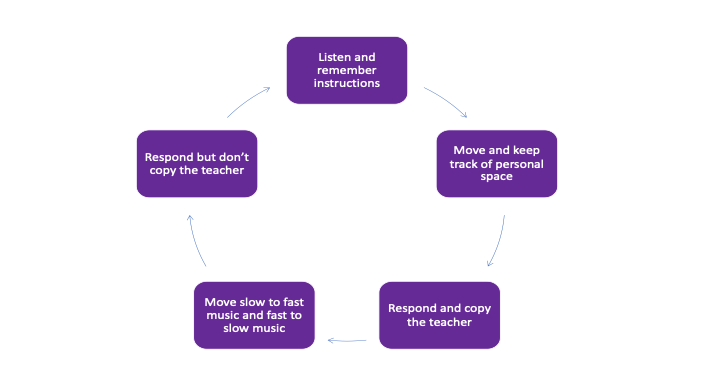Example 1:
The Better Movers and Thinkers intervention found after 16-weeks of movement games children showed a 16-point improvement in executive function.
Example 2:
Red light purple light circle time movement games.
- The intervention was added to a three-week summer school readiness program for children entering kindergarten. Teachers led the students through executive function and self-regulation games and saw improvement in both after three weeks.
- This eight-week intervention included two 20- to 30-minute sessions. Research assistants led children through movement and music-based games that increased in complexity. Children saw improvement in executive function and self-regulation with the largest gains found for English language learners.
- Circle time games improved executive function and self-regulation for children with low levels of both prior to the intervention.
No benefits on executive function and self-regulation were found in a sample of pre-kindergarten children from Nairobi, Kenya following the 8-week Red-Light Purple-Light intervention.
Executive function and self-regulation are the brains’ ability to inhibit inappropriate and impulsive behaviors (inhibitory control), hold and work with information (working memory), and shift between tasks throughout the day (cognitive flexibility). Early childhood is a sensitive period in the development of executive function and self-regulation, and the early childhood classroom is an excellent setting to promote the development of both through movement and play.
Executive function and self-regulation help children sustain attention in the classroom, inhibit attending to distracting information, hold and manipulate information in memory, and shift between indoor and outdoor activities (McClelland et al, 2007; Miyake et al., 2000). A child’s brain is hardwired with the capacity to develop strong executive function and self-regulation, and early experiences can aid the development of both (Diamond & Lee, 2011). Movement based games that encourage children to think and remember rules offer positive opportunities for children to be physically active as they engage brain systems involved in executive function and self-regulation (Dalziell et al., 2019).
Dalziell, A., Booth, J. N., Boyle, J., & Mutrie, N. (2019). Better Movers and Thinkers: An evaluation of how a novel approach to teaching physical education can impact children’s physical activity, coordination and cognition. British Educational Research Journal, 45(3), 576-591.
Diamond, A., & Lee, K. (2011). Interventions shown to aid executive function development in children 4 to 12 years old. Science, 333(6045), 959-964.
McClelland, M. M., Cameron, C. E., Connor, C. M., Farris, C. L., Jewkes, A. M., & Morrison, F. J. (2007). Links between behavioral regulation and preschoolers’ literacy, vocabulary, and math skills. Developmental psychology, 43(4), 947.
Miyake, A., Friedman, N. P., Emerson, M. J., Witzki, A. H., Howerter, A., & Wager, T. D. (2000). The unity and diversity of executive functions and their contributions to complex “frontal lobe” tasks: A latent variable analysis. Cognitive psychology, 41(1), 49-100.
Movement based interventions that require children to stop, think, and act can help improve a child’s executive function and self-regulation. Below is a description of an intervention movement game that can be played with children between the ages of 3 and 6.
Phase 1: Make the same shape
- Teacher comes up with three different shapes that a child can make with their body. For example, making one’s body into a ball, making one’s body look like a T, make a X with your body.
- As music is playing the teacher moves about the room or outdoor space and demonstrates the shapes to the children.
- Children move about the space using different methods of traveling such as hopping, skipping, and slow jogging. As the children move, they must keep track of their personal space and listen for a signal from the teacher.
- When the teacher signals, children are instructed to look and then copy the shape the teacher is making.
Phase 2: Make a different shape
- As music is playing the teacher moves about the room or outdoor space and demonstrates the shapes to the children.
- Children move about the space using different methods of traveling such as hopping, skipping, and slow jogging.
- When the teacher signals children are instructed to look and make a different shape from the one the teacher is making.
Phase 3: Moving fast to slow music, moving slow to fast music, and make the same shape
- As slow music is playing the teacher moves about the room or outdoor space and demonstrates the shapes to the children.
- As slow music is playing children move about the space at a fast paceusing different methods of traveling such as hopping, skipping, and jogging. As the children move, they must keep track of their personal space and listen for a signal from the teacher.
- As fast music is playing children move about the space at a slow paceusing different methods of travelling such as hopping, skipping, and jogging. As the children move, they must keep track of their personal space and listen for a signal from the teacher.
- During both the fast and slow music, when the teacher signals children are instructed to look and then copy the shape the teacher is making.
Phase 4: Moving fast to slow music, moving slow to fast music, and make a different shape
- As slow music is playing the teacher moves about the room or outdoor space and demonstrates the shapes to the children.
- As slow music is playing children move about the space at a fast paceusing different methods of traveling such as hopping, skipping, and jogging. As the children move, they must keep track of their personal space and listen for a signal from the teacher.
- As fast music is playing children move about the space at a slow paceusing different methods of traveling such as hopping, skipping, and jogging. As the children move, they must keep track of their personal space and listen for a signal from the teacher.
- During both the fast and slow music, when the teacher signals children are instructed to look and make a different shape from the one the teacher is making.

Encouraging movement based activities that require a child to stop, think, and remember a set of rules can help improve and promote executive function and self-regulation.
Potential Roadblocks:
Limited time and space.
Possibility of children bumping into each other.
Research Studies on the Topic:
Dalziell, A., Booth, J. N., Boyle, J., & Mutrie, N. (2019). Better Movers and
Thinkers: An evaluation of how a novel approach to teaching physical
education can impact children’s physical activity, coordination and
cognition. British Educational Research Journal, 45(3), 576-591.
McClelland, M. M., Tominey, S. L., Schmitt, S. A., Hatfield, B. E., Purpura, D.
J., Gonzales, C. R., & Tracy, A. N. (2019). Red Light, Purple Light! Results
of an intervention to promote school readiness for children from low-income
backgrounds. Frontiers in psychology, 10, 2365.
Schmitt, S. A., McClelland, M. M., Tominey, S. L., & Acock, A. C. (2015).
Strengthening school readiness for Head Start children: Evaluation of a self
regulation intervention. Early Childhood Research Quarterly, 30, 20-31
Tominey, S. L., & McClelland, M. M. (2011). Red light, purple light: Findings
from a randomized trial using circle time games to improve behavioral self-
regulation in preschool. Early Education & Development, 22(3), 489-519.
Willoughby, M. T., Piper, B., King, K. M., Nduku, T., Henny, C., &
Zimmermann, S. (2021). Testing the Efficacy of the Red-Light Purple-Light
Games in Preprimary Classrooms in Kenya. Frontiers in psychology, 12,
Level of Evidence:
Both interventions offer promising evidence for promoting executive function and self-regulation. Evidence for the Better Movers and Thinkers intervention is limited to one published study and warrants more validation. Three of the four published studies for the Red-Light Purple-Light intervention found promising evidence for promoting executive function and self-regulation but effects are not consistent across all studies.
